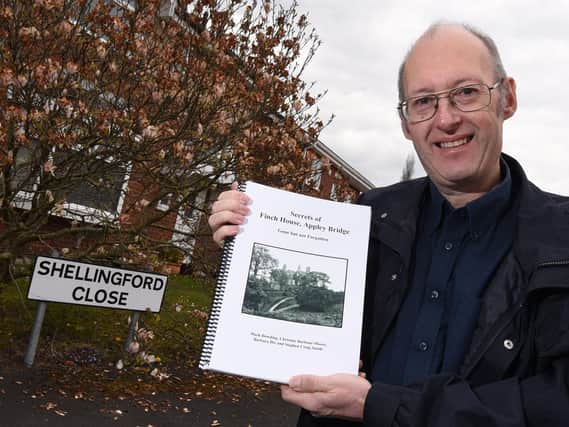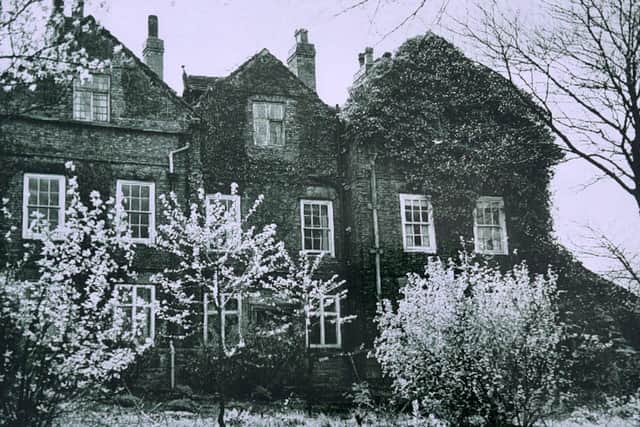New book uncovers fascinating history of historic house


The Secrets of Finch House tells the tale of the Appley Bridge residence which stood from at least the 1720s until it was pulled down in the late 1960s and the people who called it home over a period of more than 200 years.
The volume contains the work of four people and brings together research by historians and the descendants of some of those who lived at Finch House, who also contributed family memories, anecdotes and records.


Advertisement
Hide AdAdvertisement
Hide AdAfter deciding to find out more about other families who lived at the impressive old property, which stood near where Shellingford Close and Chisacre Drive are today, they approached
Christine Barbour-Moore whose family were residents at the turn of the 20th century.
Dr Smith also contacted Barbara Dix who has written a number of books about Appley Bridge and its history.
The result of all their labours is an impressive document of more than a dozen families who called Finch House home, ranging from the 18th century bishop Edward Dicconson to its final occupants in the middle of the 20th century.
Advertisement
Hide AdAdvertisement
Hide AdMark, 60, said: “With Finch House having been knocked down in the late 1960s the number of people in Appley Bridge who remember it is getting fewer and fewer.
“With the new houses being built there’s a newer population in Appley Bridge who might never have known it was there.
“It was quite an imposing building in the area. It was on a kind of mound which gave it a really good overview of the area.
“Over time the population grew and houses were needed, so eventually the land was sold off to developers and it all came down in the name of progress.
Advertisement
Hide AdAdvertisement
Hide Ad“I was sending emails backwards and forwards with Dr Smith after his article and we decided it would be a very good idea to find out more about the people who had lived there.
“The four of us who have been involved have found out all sorts of things.”
Mark shared his memories of going to visit his grandparents at Finch House as a young boy.
He said: “My grandparents lived there from about 1941 until it was knocked down. I do remember going as a child, I would have been about seven when it was knocked down.
Advertisement
Hide AdAdvertisement
Hide Ad“It was a big old rambling house. The rooms were huge. It was basically in the middle of nowhere at the time.
“There were clay pits which eventually came up to the back of the house and my sister and I would play there when we visited, which was certainly something you wouldn’t do now.
“My auntie also lived there for a few years in the 1950s with her husband and three children so it was quite a busy house at one time.
“It was split into three; there was a centre piece and then the east and west wings. My grandparents lived in the east and centre parts and the west part was lived in by various people over time.
Advertisement
Hide AdAdvertisement
Hide Ad“There were people my grandparents knew who were farmers, and they used that side of the house as a smallholding with pigs and chickens and a couple of cows.
“They moved out in about 1966 or ‘67 and a couple moved in. They were the last people to live there along with my grandparents.”
Mark’s cousins who lived in rooms on the top floor of the house put together some memories for the book and he also amassed family photographs, written memories from his late father, a transcribed conversation with his auntie who had been born and brought up there and sketches of the floors, house and gardens.
They also knew about the renowned Bishop Dicconson, whose name can still be seen around Wigan in street and building names, and a family called the Tarvers who lived there from 1891 to 1903.
Advertisement
Hide AdAdvertisement
Hide AdMs Barbour-Moore’s maternal great-grandparents and their family lived in the house at the turn of the 20th century.
Her great-grandmother had written a diary and that provided a large amount of useful information for the book.
They then used census records, marriage and death certificates, electoral rolls, business directories, local newspaper articles and other historical sources to build up a more complete picture of some of the other people who had lived at Finch House.
The finished book features sections on the house itself, three different families for which there is extensive documented evidence, other families who lived there of whom only limited evidence has so far been gathered and a conclusion with a request for further memories and photographs.
Advertisement
Hide AdAdvertisement
Hide AdAn initial run of 50 copies is being printed and they will be placed in local libraries as well as with the borough’s archives service.
The book is also available for anyone who wants to buy a copy.
To order a copy, email [email protected]
If you value what we do and are able to support us, a digital subscription is just £1 for your first month. Try us today by clicking here and viewing our offers.
